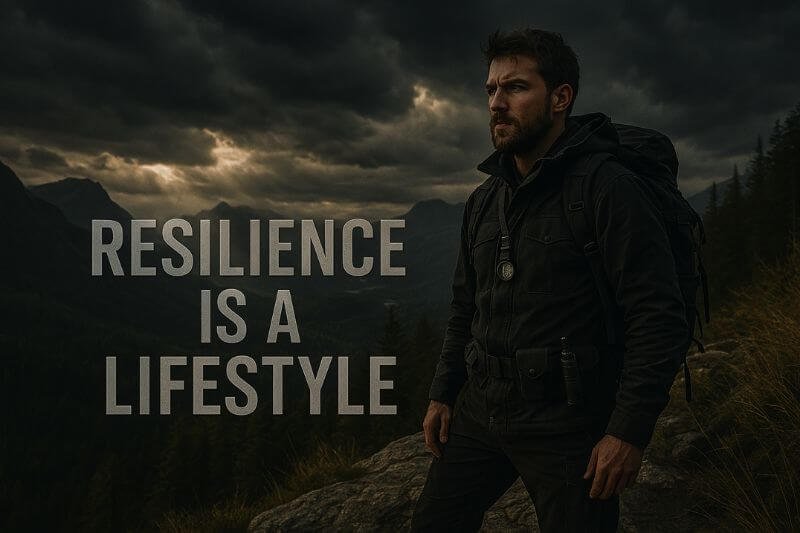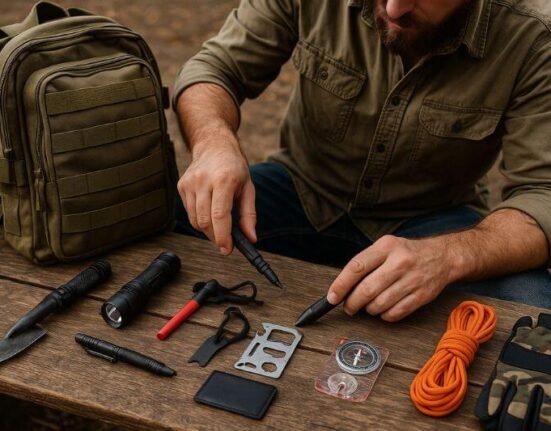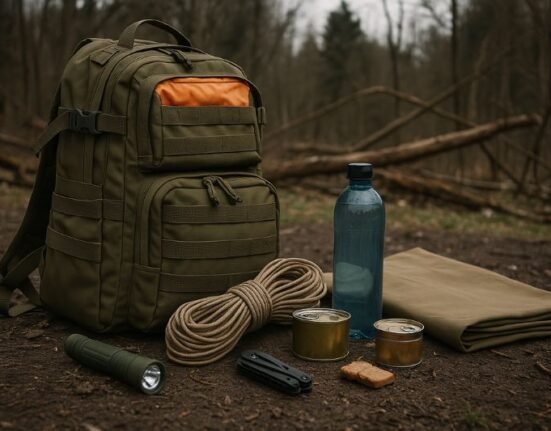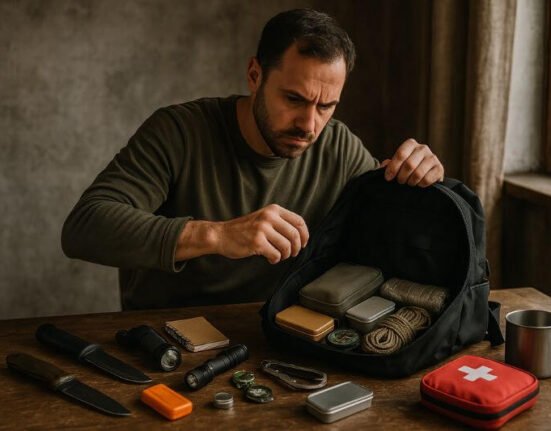In survival, plans fail. Tools break. People freeze. But the one thing that keeps you standing when the world collapses is resilience — and it’s not something you’re born with.
Resilience training is the deliberate process of forging mental and emotional strength through practice, exposure, and reflection. It’s how survivors are built — not in the moment, but in the days and months before collapse strikes.
Whether you face a blackout, conflict, famine, or personal trauma, the people who recover, adapt, and lead are those who’ve trained their mind like a muscle.
What is resilience training in a survival context?
Resilience training is not about feeling nothing. It’s about functioning well despite everything.
It’s the ability to:
- Think clearly when emotions rise
- Recover quickly from mental overload
- Stay committed to your mission despite fear or setbacks
- Maintain focus when plans fail or danger escalates
- Lead others without losing control of yourself
“Resilience isn’t about avoiding the storm. It’s about walking through it without losing your compass.”
— CivilFall Crisis Readiness Manual
In crisis situations, you won’t rise to your potential — you’ll fall to your level of training.
Why most preppers neglect mental resilience
Most preppers focus on gear, food, shelter, and tactics — all essential.
But without mental resilience, it all collapses:
- You forget your plan
- You argue with your team
- You freeze under pressure
- You spiral in guilt or fear after a bad decision
- You lose energy and focus at the worst moment
And here’s the truth: these outcomes aren’t rare — they’re default when the mind is untrained.
Signs your resilience is weak (and where to start)
Even in everyday life, you can spot cracks in your mental armor.
Watch for:
- Overreaction to small stress
- Avoidance of uncomfortable situations
- Constant second-guessing
- Mental crash after failure
- Struggle to recover from emotional hits
None of this means you’re weak — it means your resilience is untrained.
Building Resilience Step by Step: Drills, Habits, and Exposure
You don’t build mental toughness in theory. You build it through pressure, recovery, and repetition.
Resilience training isn’t about doing one hard thing — it’s about building a foundation of habits and drills that rewire your mind for endurance and adaptation.
Use micro-stressors to build daily resilience
The most effective way to train your mind for collapse is to simulate discomfort in safe environments.
This creates stress inoculation — where your nervous system stops interpreting discomfort as danger.
Here’s a weekly plan to start:
| Day | Micro-Stressor Challenge | Mental Benefit |
|---|---|---|
| Monday | Cold shower (2–3 minutes) | Breath control under shock |
| Tuesday | No phone until noon | Focus and stimulus control |
| Wednesday | Skip one meal intentionally | Hunger tolerance and energy shift |
| Thursday | Walk in silence for 1 hour | Reflection, sensory awareness |
| Friday | Train in the rain or cold outdoors | Environmental acceptance |
These drills condition your body and mind to respond — not react.
Use a resilience journal
Writing is not just reflection. It’s cognitive restructuring.
Each day, write:
- 1 stressor you faced
- How you responded
- What emotion you felt
- What you learned
- What you’ll do next time
This teaches your brain to find meaning in pain — the cornerstone of post-crisis growth.
“You don’t learn resilience by succeeding. You learn it by standing up again.”
— CivilFall Mental Endurance Series
Practice failure drills
Most people only train for success. But in real survival, plans break.
Choose one task per week and intentionally make it harder or introduce a failure point:
- Set up your tent blindfolded
- Navigate with no compass
- Build fire with wet wood
- Simulate evacuation in total darkness
- Hike with a torn map and no GPS
The goal isn’t to succeed. The goal is to practice adaptation under frustration.
Apply the 3R Method: Recognize, Reset, Reengage
When emotions spike, resilience means pausing and pivoting.
- Recognize: “I’m flooded. I feel panic, anger, despair.”
- Reset: Box breathing (inhale 4 – hold 4 – exhale 4 – hold 4)
- Reengage: Choose one micro-task and take action immediately
This 60-second sequence can save your life — or someone else’s.
Build discomfort capacity through physical training
You don’t need to be a Navy SEAL. But you do need to train your body to keep moving when your mind says stop.
Once a week, push your limits in a controlled way:
- Weighted ruck for 2+ hours
- 24h fast with physical work
- Sleep outside in cold
- Perform mental tasks after hard exercise (e.g. map reading)
- Lead a group exercise while exhausted
Why? Because decision-making and composure fail under fatigue — unless trained.
Real-World Resilience: Performing Under Pressure When It Counts
Training is theory. Crisis is truth.
When things go wrong — and they will — your ability to recover mentally, think clearly, and act deliberately is what defines true resilience.
What real resilience looks like in collapse
Picture this: total blackout. No signal. Streets filled with confusion. You haven’t slept. Your child is crying. The neighbor’s screaming. You can’t reach anyone.
Most people panic. Or break. Or freeze.
But the resilient:
- Focus on the immediate task
- Use their breath to stay centered
- Isolate the noise from the threat
- Lead their group with clarity
- Think in actions, not emotions
They still feel fear — but it doesn’t own them.
“Resilience is not being calm. It’s being able to return to clarity faster than chaos can consume you.”
— CivilFall Behavioral Survival Doctrine
Common failures when resilience is untrained
Even seasoned preppers can fall into these traps:
- Mental crash after one bad decision (“I blew it. We’re doomed.”)
- Argument-based paralysis (“We’re wasting time debating.”)
- Perfectionist freeze (“We can’t move until the plan is clean.”)
- Emotional hijack (rage, despair, or denial dominate logic)
Resilience training isn’t about never falling — it’s about getting up fast.
The power of regrouping moments
One of the most underused tools in a collapse is the 5-minute regroup.
Every hour, ask:
- What just happened?
- What changed?
- Who needs support?
- What’s our new priority?
This protects morale and recalibrates focus — especially when things get messy.
Group resilience: spreading clarity under pressure
Resilient leaders spread calm.
Here’s how to transfer resilience to others in your group:
- Use tone and pace: speak low and slow
- Give people control: assign micro-responsibilities
- Normalize mistakes: “It’s fine. Reset and move.”
- Use eye contact and physical grounding (touch shoulder, hand on back)
- Inject realism + hope: “It’s tough, but we’ve trained. We can do this.”
You’re not just surviving for you — you’re anchoring others.
Frequently Asked Questions (FAQ) – Resilience Training for Crisis
When it comes to resilience training, a lot of people carry questions, doubts, and even fears. That’s normal. You’re not alone. Below are the most important and frequently asked questions, answered in a way that blends science, experience, and survival realism — not just theory.
These aren’t one-liner answers. They’re insights forged from the field, psychology, and hard-won clarity. Let’s go.
What exactly is resilience training — and why does it matter in survival?
Resilience training is the structured process of preparing your mind and emotions to perform, recover, and adapt in high-stress or extreme situations.
It’s not about pretending things are fine when they’re not. It’s about teaching your brain to do two things well:
- Stay functional under pressure
- Bounce back quickly after overload
In a survival context, this could mean:
- Thinking clearly after seeing someone injured
- Staying focused while hungry, cold, or sleep-deprived
- Leading your group while your own emotions spike
- Reorienting your plan after a failure, not spiraling into despair
Resilience is what keeps your mental systems online when everything around you is breaking.
You don’t train resilience because it feels good. You train it because collapse doesn’t care how you feel.
How is resilience different from mental toughness?
Good question — and one that gets misunderstood a lot.
Mental toughness is about grit. It’s the ability to push through pain, pressure, or exhaustion. It’s front-facing. It’s external. It’s what lets you finish the mission no matter what.
Resilience, on the other hand, is more internal. It’s about recovery. It’s the ability to take the hit and still come back to center. It’s what lets you rest, reflect, adjust — and then return stronger.
Think of it like this:
| Trait | Mental Toughness | Resilience |
|---|---|---|
| Key focus | Pushing through discomfort | Recovering from impact |
| Used when | Facing external challenge | Managing emotional/internal fallout |
| Metaphor | Hammering forward through the wall | Rebuilding after the collapse |
| Example in crisis | Keep moving despite fear | Re-center after a plan failure or trauma |
In survival, you need both. But without resilience, toughness breaks down.
Can resilience really be trained — even if I’ve dealt with anxiety, trauma, or depression?
Absolutely. And not only can it be trained — it must be, especially if you’ve faced trauma.
Resilience is like a psychological immune system. And just like physical immunity, it can be weakened by past wounds… or strengthened by intentional habits.
Many people with anxiety or PTSD believe they’re “too fragile” to handle pressure. But often, they’ve already been through hell — and what they lack is a framework for recovery, not strength.
Here’s the truth:
- Resilience doesn’t deny trauma. It gives it space to exist without letting it rule.
- Resilience doesn’t erase anxiety. It helps you work through it.
- Resilience isn’t built in the absence of pain — it’s forged inside it.
With structure, support, and practice, even the most emotionally sensitive people can become mentally unbreakable.
How long does it take to build real resilience?
That depends on how you train — and how consistent you are.
But here’s a realistic timeline for most people:
- Week 1–2: Awareness. You start noticing your reactions, your patterns, and your mental limits.
- Week 3–6: Friction. You’ll start hitting resistance. Emotions, excuses, fatigue. This is where many quit.
- Week 7–12: Adaptation. Habits kick in. Emotional regulation improves. You recover faster.
- 3–6 months: Transformation. People around you notice the change. You no longer break — you bend and return stronger.
After that? It becomes a lifestyle. You don’t “finish” resilience. You maintain it.
Just like physical fitness, resilience is a long-term investment — not a one-time challenge.
Do I need to simulate extreme survival situations to build resilience?
No. You don’t need to jump into freezing water or live in the woods for a week (unless you want to). Real resilience is built through low-risk, high-friction training in daily life.
Here are examples:
- Physical: Carry your pack on hikes. Walk in bad weather. Train while hungry.
- Cognitive: Work under time limits. Solve problems after exercise. Limit your decision-making windows.
- Emotional: Sit with discomfort. Journal after conflict. Reflect on fear without escaping it.
- Relational: Lead when uncertain. Speak clearly in group settings. De-escalate tension.
Every time you lean into discomfort and return from it without crumbling, you’re building resilience.
So no — you don’t need chaos to train for chaos. You need discipline.
Is journaling really that effective for resilience?
Yes. More than you think.
Journaling rewires the brain. When you write:
- You slow your thoughts
- You organize your chaos
- You observe your reactions instead of being owned by them
It’s like downloading emotional data, processing it, and integrating the lesson.
Try this every night:
- What challenged me today?
- How did I respond?
- What do I feel now?
- What did I learn?
- What would I do next time?
Over time, your journal becomes a resilience map — showing exactly how far you’ve come and where your blind spots still are.
What’s the fastest way to recover after emotional overload in the field?
Use what we call the 3R Method. It’s simple, portable, and field-tested.
- Recognize
Name the overload. “I’m overwhelmed. I’m panicking. I’m freezing.” Labeling helps contain it. - Reset
Use breath and stillness. Inhale 4 – hold 4 – exhale 4 – hold 4. Ground your feet. Look around. Anchor to the now. - Reengage
Pick one small, actionable task. Secure a door. Gather your group. Repack your bag. Boil water.
This sequence moves you from emotional shutdown to structured clarity in less than a minute.
It’s not magic. It’s method. And with practice, it becomes automatic.
How do I teach resilience to others — especially my family or group?
You teach resilience the way you train it: through modeling, repetition, and empathy.
Here’s how:
- Model it first
Don’t tell your kids or team “stay calm” while you’re freaking out. Show them how to breathe, adapt, and reflect. Actions teach deeper than words. - Use shared rituals
Have weekly resilience nights. Challenge each other. Do discomfort drills together. Make journaling part of your family culture. - Talk about emotions, but re-anchor to action
“It’s okay to be scared. Now what’s one thing we can do right now?” That’s leadership. - Celebrate recovery, not perfection
Reward the bounce-back, not the flawless performance. This trains people to keep trying after a mistake — not to fear failure.
Over time, your family or group will stop seeing resilience as “grit” and start experiencing it as adaptability with meaning.
Final reflection: What happens if I don’t build resilience?
That’s the question most people don’t ask — until it’s too late.
Without resilience, here’s what happens when crisis hits:
- You break down after one bad call
- You lash out when emotions rise
- You withdraw from your group
- You spiral mentally after the first injury, mistake, or unexpected turn
- You survive physically… but collapse emotionally
The cost isn’t just personal. It affects your decisions, your family, your team. And in survival, clarity is everything.
Resilience is not optional. It’s foundational.
You won’t rise to the level of your hopes.
You’ll fall to the level of your mental training.
So start today. Start small. And never stop.
Because one day — maybe soon — the only thing keeping you functional may not be your gear, your skills, or your food.
It’ll be your mind.
Final takeaway: Resilience isn’t optional — it’s your foundation
In a real collapse, your greatest asset isn’t your tools, your body, or your plans.
It’s your ability to get up when the world pushes you down.
Train for discomfort. Reflect on struggle. Practice failure. Lead with clarity.
Because when SHTF, the survivors are those who trained their minds to bend — but never break.















